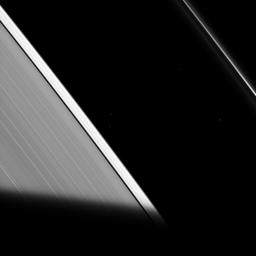
|
Cool Shadow
- Click the image above for a larger view
- Full-Res JPEG (1016 x 1016) (42.4 kB)
- Full-Res TIFF (1016 x 1016) (1.0 MB)
Caption:
Originally released on Oct. 7, 2013
The shadow of Saturn cuts across the rings in this recent Cassini spacecraft image. As the ring particles enter Saturn's shadow, their temperature drops to even colder temperatures, only to warm back up again when they re-emerge into the sunlight. Ring scientists think that these temperature swings may help change the physical properties of the ring particles.
Eight stars are visible in this image, including one through the rings.
This view looks toward the unilluminated side of the rings from about 56 degrees below the ringplane. The image was taken in visible violet light with the Cassini spacecraft narrow-angle camera on May 29, 2013.
The view was acquired at a distance of approximately 639,000 miles (1.0 million kilometers) from Saturn and at a Sun-Saturn-spacecraft, or phase, angle of 128 degrees. Image scale is 4 miles (6 kilometers) per pixel.
Background Info:
The Cassini-Huygens mission is a cooperative project of NASA, the European Space Agency and the Italian Space Agency. The Jet Propulsion Laboratory, a division of the California Institute of Technology in Pasadena, manages the mission for NASA's Science Mission Directorate, Washington, D.C. The Cassini orbiter and its two onboard cameras were designed, developed and assembled at JPL. The imaging operations center is based at the Space Science Institute in Boulder, Colo.
For more information about the Cassini-Huygens mission visit http://saturn.jpl.nasa.gov and http://www.nasa.gov/cassini . The Cassini imaging team homepage is at http://ciclops.org .
Cataloging Keywords:
| Name | Value | Additional Values |
|---|---|---|
| Target | Saturn Rings | Saturn |
| System | Saturn | |
| Target Type | Ring | Planet |
| Mission | Cassini-Huygens | |
| Instrument Host | Cassini Orbiter | |
| Host Type | Orbiter | |
| Instrument | Imaging Science Subsystem (ISS) | |
| Detector | Narrow Angle Camera | |
| Extra Keywords | Disk, Grayscale, Shadow, Visual | |
| Acquisition Date | ||
| Release Date | 2013-10-17 | |
| Date in Caption | 2013-05-29 | 2013-10-07 |
| Image Credit | NASA/JPL-Caltech/Space Science Institute | |
| Source | photojournal.jpl.nasa.gov/catalog/PIA17137 | |
| Identifier | PIA17137 | |
